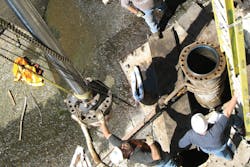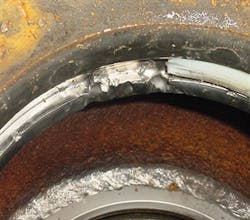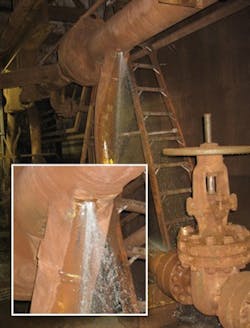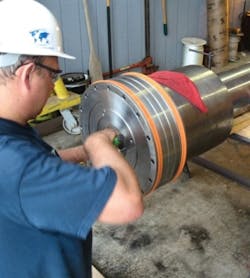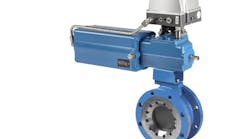Designing a high-pressure water hydraulic system is no easy task. First, the engineer must select the proper high-pressure water valve design as well as the valve’s optimal configuration. Then, the appropriate materials of construction for the valves and valve components must be selected based on corrosion level, temperature and pressure of the application.
This article discusses best practices for managing industrial valve leakage and implementing a preventive maintenance program. Planning ahead for valve selection, leakage and maintenance will help ensure the long-term safety and reliable performance of the high-pressure hydraulic system.
Minimize industrial valve leakage
Hydraulic system leakage saps a facility’s efficiency, increases costs, and exposes plant personnel and the environment to potentially dangerous conditions.
Damage to the valve body resulting from leakage past the worn seal
Understand internal & external leakage
External leaks appear as drips and puddles that collect on plant floors or equipment, increasing the risk of slips and falls. These leaks can be dangerous to workers, the general public and the environment. The loss of flow media in a closed-loop system has a negative impact on the efficiency of that system. External leakage can also result in lower operating pressure, which can lead to vibrations that can cause excessive stress on system components.
Unintentional internal leakage through a valve can result in a system that operates inefficiently, impacting the system’s pressure, temperature, flow and velocity. In most cases, this will result in equipment not operating as it was intended, leading to inconsistencies in the processes that rely on the hydraulic circuit.
Review industry standards for leakage tolerance
Every plant engineer must decide how much valve leakage will be inevitable and therefore tolerable for his or her application. The following industry standards were created for different types of valves:
- Manufacturers Standard Society (MSS) Standard SP-61 – Establishes allowable leakage in valves that operate as isolation or check valves
- American National Standards Institute (ANSI) Standard 70-2 – Sets different leakage classifications for control valves, ranging from Class I (unspecified amount of leakage) to Class V (zero leakage)
While the above standards were developed to establish guidelines for valve manufacturers to use during industrial valve design, they use a specific set of operating parameters such as viscosity, pressure and temperature when measuring leakage.
External leakage because of erosion in the piping system
Put the valve in a position to succeed
The following conditions may cause industrial valve leakage:
- Improper valve operation – A spool valve designed to operate within a certain range of temperatures, pressures and flow velocities will not operate as intended if it is operated outside of that range. The problem may be that the system as a whole presents conditions that cause the valve to leak.
- Contamination in flow media – Dirt or unintended particles flowing in the media can cause a valve to leak for a couple of reasons. First, the particles will cause premature wear as they travel at high speed through the circuit. Second, these particles can prohibit the mating surfaces of the valve shut-off point to mate correctly, allowing gaps in which leakage can occur. If flow media are capable of escaping the system in the form of a leak, then contaminants can enter the system though that same point. Contamination can be controlled by filtering the flow media and by consistently monitoring it for cleanliness.
- Misalignment between valve stem and actuator stem – If the two stems are misaligned, an uneven force can be applied to the valve shut-off surfaces, which can allow leakage to occur at that point. Any uneven force on the valve stem will also create issues with the packing surrounding the stem. The valve actuator also needs to be regularly inspected and tested to ensure it is operating as intended. If it is not capable of mating the shut-off surfaces with the required seating load, leaks will occur.
The majority of leakage causes can be minimized by adhering to a regular preventive maintenance program. Following are ways to maximize the benefits of preventive maintenance for industrial valves.
Realize the benefits of preventive maintenance
Any failure of any single component in a hydraulic system can lead to productivity loss and threaten the safety of workers, the public and the environment. A preventive maintenance program designed to keep all of those components in service can help mitigate those risks. This program establishes time or condition intervals for performing a set list of tasks to prevent a piece of equipment from failing.
Gain staff buy-in with a proactive approach
To make the transition to a more proactive approach, the value of the valve preventive maintenance program must be clearly communicated to all levels of the organization, highlighting specific benefits that target individual audiences.
For the front office, the plant engineer should emphasize the impact on profitability. Profitability may be of lesser concern to the maintenance crew, who might view the installation of a preventive maintenance program as heaping more work on them. But it may win the crew’s support to learn that a valve preventive maintenance program will reduce unexpected failures that require them to work on weekends or holidays. The goal is to get everyone to realize that a preventive maintenance program will benefit the company as a whole.
Hydraulic cylinder piston replacement
Build a solid foundation with an equipment database
Follow these four steps to create an equipment database for an industrial valve preventive maintenance program:
- Identify and assign a label for each valve in the system.
- Log every valve into a database-management program, whether that’s a complex computerized maintenance management system program or a self-made spreadsheet.
- Be sure to include the valve type, date of installation, manufacturer, location and function.
- Give each industrial valve a designation and label it in the field with that designation using a tag, barcode or signage.
Write effective preventive maintenance procedures
Effective preventive maintenance procedures must include:
- Service intervals
- A list of required parts to complete the service
- Any necessary special tools
- Lockout/tagout requirements
- Step-by-step instructions for performing the required task
- Photos or video footage outlining the steps of the preventive procedure (Bonus)
Once the procedures are established, all maintenance department employees should be trained in the procedures to ensure consistent practices. Then all service that takes place will become part of that high-pressure water valve’s permanent record.
Hunt Valve brings nearly 100 years of fluid power engineering innovations and solutions to a wide range of industrial and military customers. It specializes in severe-duty valves and complementary engineered components and system solutions for applications that include primary metals (steel, aluminum), energy (nuclear, hydro, downstream oil and gas), process (chemical) and U.S. Navy nuclear-powered vessels, including all submarines and carriers in operation as well as the Virginia Class, Ford Class and soon-to-be-in-production Ohio Replacement. To learn more, visit huntvalve.com.
